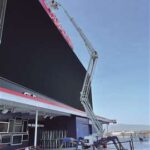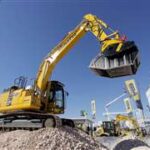The Ultimate Guide to Construction Cranes: Types and Applications
Construction cranes are essential to the building industry. Whether it’s lifting heavy materials to great heights or moving massive structures, cranes play a pivotal role in shaping the skyline and facilitating infrastructure projects. While tower cranes are the first type that comes to mind, the world of cranes is incredibly diverse. Each crane is designed to meet the unique demands of different construction projects, making the choice of crane an important decision for any builder.
This guide takes you through the various types of construction cranes, shedding light on their specific functions and how they contribute to the success of a project.
Mobile Cranes: Flexibility in Motion
-
All-Terrain Mobile Cranes
All-terrain mobile cranes are equipped with tough tires and a durable chassis, making them perfect for navigating both urban streets and rugged terrain. These cranes combine mobility and a heavy lifting capacity, allowing them to access areas that might otherwise be difficult to reach, all while maintaining a high level of efficiency. -
Rough Terrain Cranes
Designed specifically for outdoor use, rough terrain cranes are built to handle challenging landscapes. They feature four-wheel drive and rugged tires that make them ideal for projects in areas with uneven ground. These cranes offer flexibility and the power needed to lift heavy loads, even in difficult conditions. -
Truck-Mounted Cranes
Truck-mounted cranes bring added convenience to the table, as they can be easily transported from one site to another. This mobility is perfect for projects that require quick setups and constant relocation, making them the go-to option for projects with tight deadlines.
Mobile cranes are celebrated for their quick setup times and their ability to move seamlessly between job sites. They are highly versatile, making them suitable for a wide range of construction needs.
Tower Cranes: The Giants of Construction
Tower cranes are the undisputed heavyweights of the crane world, essential for high-rise building projects. With their long horizontal jibs and towering heights, tower cranes can cover expansive areas and move heavy materials to great heights. Their ability to lift both vertically and horizontally is crucial in constructing modern urban landscapes.
Crawler Cranes: The Powerhouses
Crawler cranes, with their track-based design, offer stability and mobility, even in difficult terrains. These cranes are perfect for large-scale projects such as bridge construction or wind turbine installations. While they may be challenging to transport and set up, their rugged design and ability to handle extreme loads make them a favorite for heavy-duty tasks.
Floating Cranes: Designed for Marine Construction
For projects in aquatic environments, floating cranes are a must. Mounted on pontoons or barges, these cranes are built to operate on water, providing stability and precise load handling in marine conditions. They are essential for tasks like bridge building and offshore oil rig maintenance.
Telescopic Cranes: Adaptability at Its Best
Telescopic cranes are perfect for urban environments, offering adjustable boom lengths that allow them to adapt to various heights and confined spaces. Their extendable booms function much like a telescope, enabling them to reach hard-to-access places with ease.
Loader Cranes: Efficient and Compact
Loader cranes are mounted on trucks or trailers and are designed for quick loading and unloading of materials. Their compact size doesn’t compromise their lifting power, making them ideal for sites with limited space or for operations that require frequent transportation.
Overhead Cranes: Optimizing Indoor Efficiency
Overhead cranes, or bridge cranes, are key in manufacturing settings and indoor environments. They move loads along fixed overhead tracks, maximizing floor space and ensuring safety by keeping the ground clear of obstructions. This design makes them invaluable in warehouses, factories, and other confined spaces.
Conclusion
Choosing the right crane is more than just about picking a machine—it’s about enhancing project efficiency, ensuring safety, and managing costs effectively. Each crane type is engineered to meet specific operational demands, ensuring that they serve a vital role in today’s complex construction landscape. Whether it’s for lifting, moving, or placing heavy loads, the right crane can make a significant difference in the success of a project.
When considering equipment for your next construction venture, take a look at the range of cranes offered by Sany. With options like truck-mounted, all-terrain, crawler, rough terrain, telescopic, and tower cranes, you can find the right equipment for any job. With lifting capacities from 5 tons to 3200 tons and advanced hydraulic systems, Sany’s cranes are built to handle a variety of projects with maximum efficiency and reliability.




